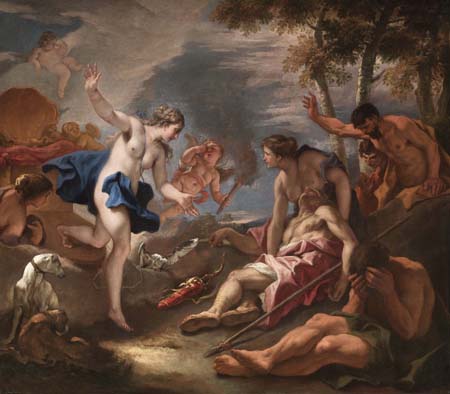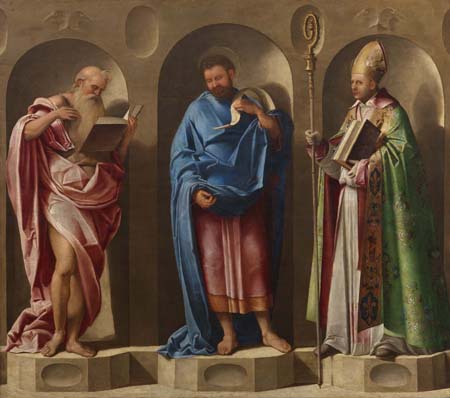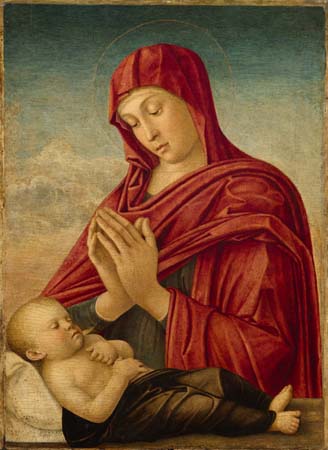
Sebastiano Ricci, Venere accorre da Adone morente

Benedetto Diana, San Marco tra i Santi Girolamo e Lodovico da Tolosa
Alessandro Varotari detto il Padovanino. Leda e il cigno
Canaletto, Capriccio architettonico
The exhibition at Museo Correr, Venice, FROM BELLINI TO TIEPOLO. Great Venetian painting from Sorlini Foundation, from October 29, 2005 to February 26, 2006 presented a rich selection of works from the vast Sorlini collection. These fifty Venetian paintings date from the fifteenth to the eighteenth century and usually hang in the various residences of the family. Here, they were brought together for the first time in a public exhibition that provides a most stimulating account of three centuries of art in the Venetian Republic.
This exhibition not only presented the public with an important collection of paintings produced in the Venetian Republic from the fifteenth to the eighteenth century, it also charted the growth of the collection put together by Luciano and Agnese Sorlini. The fruit of a love of art and a passionate interest in culture, the collection began in the immediate post-war period, initially to provide works that would embellish the couple’s homes in Lombardy and the Veneto. Ultimately, in 2002, it would lead to the creation of the Fondazione Luciano e Agnese Sorlini in the Brescia area, intended to make this extraordinary assembly of artistic wealth available to the public.
Housed in the neo-classical area on the first floor of the Museo Correr, the exhibition comprised fifty paintings from Venice and the surrounding area. Dating from the fifteenth to the eighteenth century, these normally hang in the family’s various residences, but were here gathered together to provide a stimulating insight into the development of art within the Venetian Republic. Amongst the works on loan one that stands out is the

Giovanni Bellini Madonna and Child (formerly the Contini Bonacossi Madonna).
However, it is the very completeness and variety of the works that was surprising. The artists represented include Padovanino, Sebastiano and Marco Ricci, Gianantonio Pellgrini, Jacopo Amigoni, Canaletto, Francesco Guardi, Pietro Longhi and Giandomenico Tiepolo; and the works – sacred images, mytholgical scenes, landscapes, vedute and portraits – effectively summarise the ideas, values and variety of artistic languages within Venetian culture as a whole.

Giandomenico Tiepolo Christ and the Samaritan Woman at the Well
In October 1750 Giambattista Tiepolo left Venice for the Bishopric of Wűrzburg in Franconia, called to decorate the dining hall in the Residence of the reigning bishop, Carl Philipp von Greiffenklau; later he would also be commissioned to do frescoes for the enormous ceremonial staircase in the building. With him he took his two sons, Giandomenico and Lorenzo; the former had already been his accomplished assistant for some years, the latter, though still young – he was born in 1726 – was also intended for a career as an artist. During the three years spent in Wűrzburg, Giandomenico not only assisted his father in work on the Residence frescoes but was also commissioned to do paintings for local notables. This is one of those works and shows the moment when Christ, halting on his journey from Judea to Galilee, reveals his divine mission to a Samarian woman who has given him to drink of the water of Jacob’s Well in the village of Sychar. Whilst still clearly influenced by his father’s art, the young Giandomenico also reveals himself capable of a more intimate, delicate artistic language. Perhaps this is to be seen in relation to the taste of his clients, in a Germany where Protestant pietism eschewed the triumphalism of the Catholic Church and saw religion much more as a question of individual sentiment.

Giambattista Tiepolo The Angel of Fame
This is one of the two surviving fragments from a large-format work painted for the ceiling of the main hall in Palazzo Grimani ai Servi in Venice, which was destroyed by fire in the early years of the nineteenth century. Perhaps that was when Tiepolo’s work was lost, leaving only the two fragments; the other became part of the Uffizi collections in the year 1900. Sources do not record the subject-matter of Tiepolo’s ceiling; but there can be no doubt that it served to celebrate the glory and power of a patrician family that in 1740 was recorded as being the second richest in Venice. This is confirmed by the presence of this Angel of Fame, whose trumpet sounds the glories of the family throughout the whole world; in the Florentine fragment there is a putto holding a laurel crown, which was clearly intended for the head of a Grimani who would serve as a symbol for the entire family.

